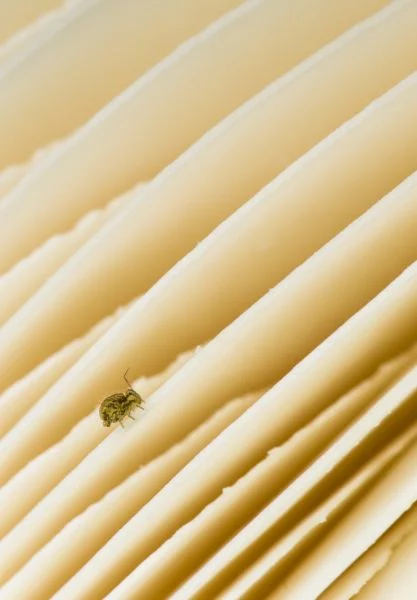Are Springtails Harmful | Green Wave Pest Solutions
Home » Blog » Are Springtails Harmful | Green Wave Pest Solutions
Are Springtails Harmful
Springtails are tiny insects that are often confused with fleas. They’re more closely related to grasshoppers and crickets, but they do resemble fleas in size and shape. Springtails can be found all over the world and have been documented as far back as 1833 by German zoologist Johann Friedrich von Brandt. They feed on a wide range of things from plants to fungi, dead animals or even live ones!
What Do Spring Tails Look Like?

They look like jumping beans due to their ability to jump up high when disturbed or excited. What this means is if you see them crawling around your house near floor level it’s likely because they were startled by something closeby.
Springtails are small insects that are found in moist, dark environments. They can be found on your lawn or near a puddle if you live close to one. Springtails are harmless and do not bite people; however, they may cause an allergic reaction in some individuals who have very sensitive skin.
To prevent this from happening, make sure to wear gloves when handling these creatures!
Should I worry about springtails?
Springtails are not a danger to people, pets, or the structures of buildings; they can however become an invading pest that enters homes in large numbers and becomes quite a nuisance.
They’re often confused with fleas because their ability to jump and small size make them seem like any other tiny insect – but springtails don’t bite!
Springtail pests will only invade your home if given access by you. Thankfully these pesky little insects do more harm than good as long as it’s just one or two coming into contact at once instead of thousands over time- which is hard for them considering how difficult jumping from high places tends to be when there isn’t enough land
Are Springtails A Danger to People
Though they are not a danger to people, pets or buildings, these insects can enter homes in large numbers and be quite troublesome. They jump well too making them difficult to identify as fleas which do bite and transmit diseases
There are many things that contribute to the presence of springtails in a home. First, they have an uncanny ability to jump which can lead them into areas like walls where there may not be any direct pathway for entry from outdoors; or it’s possible their eggs were laid on someone else’s shoes and then came indoors with them.
Second, springtails seek out dark spaces such as cracks and crevices under furniture so you might find these critters hiding behind your sofa cushions when no one has been sitting on those seats recently!
Springtail invasions happen more often than we realize because they come inside our homes by jumping up onto windowsills during heavy rainfall events where water enters structures through leaks around doors and window frames.
Will springtails ever go away?
If you have a moisture problem in your walls, it is possible that small bugs called springtails might be living there. These little bugs are usually harmless and they can go away on their own after spending some time inside by heating up the house to dry out any wet spots.
Moisture and little bugs don’t sound like much, but they can cause real problems for your home. If you have a moisture problem in the walls of your house that is still present after years of heating and cooling, call us now to come take care of it!
What are Springtails?
Springtails are small insects that live in moist and humid areas. They can be found just about anywhere, including your kitchen sink or bathroom tub. These bugs have a little tail-like structure on their backside that emits a springing motion when they jump around – hence the name “springtail.”
Though this bug is typically seen as harmless, it can cause problems for any location with excessive moisture issues such as home walls and basements.
The problem: excess moisture in your house from leaks, condensation, mold growth etc… will potentially create an environment where these critters thrive by providing them shelter to nest and food sources such as dust mites.
When you consider how often we turn on our faucets, bathe and do laundry in one day – it becomes crucial to have a way to prevent these bugs from coming into your home.
What are the options to keep out Springtails?
Window screens should be cleaned on both sides of the frame twice per year (springtime and fall) with soap and water while also checking for damage or holes that may provide entry points for pests.
If you can’t wash your window screens then they need to be replaced as often as possible because any openings will allow these critters inside.
How To Get Rid Of Springtails In Skin

Contrary to what you might think, springtails are not insects. They’re actually a type of arachnid that live in moist soil and rotting wood.
Springtails can enter your skin through cuts or scrapes on the bottom of your feet (or hands). This is because they use their mouthparts called chelicerae – which look like pincers with fangs at each end-to break open dead plant matter for food inside trees.
This tears off bits into small pieces that easily fit into porous areas such as scratches from shoes, branches or bushes brushing against bare arms while walking through thickets etc., and also between toes where there may be sweat accumulated under nails due to wetness arising from humidity combined with heat–they are attracted to the salt.
Springtails are not harmful, but they can be irritating because of their tendency to crawl inside clothes and bite skin with mouthparts that resemble pincers when handled.
They have a reputation as being disease-carriers because it is possible for them to carry animal feces, mites and other insects on their body surface which might then contaminate your food or enter through an open sore.
Can Springtails Harm You
The only way springtails could harm you would be if they were drawn into your lungs by breathing deeply while lying down – this can cause infection in people who are susceptible due to asthma etc., so prevention should take place before bedtime by removing any sources (such as clothing) where these pests may find shelter.
Springtail Dermatitis
The symptoms of springtails dermatitis are small, red bumps on the skin that can be both itchy and painful. The rash is often mistaken for allergic reactions to grass or tree pollen but this condition has a clear cause: an infestation with microscopic pests called Springtailed Tetranychidae.
These insects have sharp probosces which they use to pierce through hair follicles as well as stratum corneum epidermis layers in order feed off sebum oil from glands located there
Springtail Dermatitis Symptoms
Symptoms include itching and burning sensations around areas where these bugs bite into your flesh making you want to scratch at them constantly while other people may notice slight bleeding when scratched due easy tearing of superficial blood vessels found near afflicted areas.
Springtail Dermatitis Treatment: This condition can be treated easily with the use of topical antifungal medications. These are administered in order to kill off these pests as well as their eggs and larvae which are often found living close by skin areas where they typically feed on sebum oil.
It is not recommended to apply anything else without first consulting a doctor or pharmacist and you should never scratch at your affected area because this will only make things worse, leading to even more itching and possibly infection from bacteria accumulating under fingernails while also worsening any existing rash caused by scratching at those same locations.
What Kills Springtails In Humans
Males are the most likely to be infected with T. gondii, but a female can also become infected from contact with her young offspring. Once she has given birth and starts lactating again. In this case, there’s not much we can do other than wait it out for when they’re old enough to get vaccinated themselves!
Springtails are insects that may seem harmless because they are too small to notice when they crawl on you. But these tiny animals carry a parasite called toxoplasma gondii, which causes an infection in some animals, including humans. The springtails die from this parasite as well.
The question of what kills pests in humans is a complex one. There are many answers to this question, depending on the type of pest and where it’s located inside your home or business.
Here at Green Wave Pest Solutions we’re always glad to help you identify any potential infestation so that our experts can come up with an effective plan for eliminating it from your property!
Springtails In Bed Sheets
With the onset of spring and warmer weather, there is a need to clean out closets. If you weren’t aware that bed sheets are breeding grounds for insects such as Springtails (tiny bugs with 6 legs) then we can help educate about it!
These pests thrive in moist environments so make sure your linen closet has some sort of humidifier installed or wipe down each sheet after use before putting them back on the shelf.
Springtime means it’s time again to start cleaning up our homes from winter storage clutter – but did you know this also includes getting rid of creepy-crawlers lurking in your bedroom?
Bedsheets serve as an ideal environment for tiny six-legged creatures like Springtails (aka “mites”).
Springtails are a form of arthropod in the order Collembola. They live on land and feed primarily on plant detritus, fungi, algae, lichens and organic debris.
This makes them helpful because they clean up dead plants which can decompose without oxygen to produce methane gas.
However these same behaviors make them unwelcome guests. They may be found living in homes near damp areas such as bathrooms or kitchens where stale food is present.
Springtails will use dust particles for moisture but do not require any additional sources of water for survival so it’s possible that once inside your home there will never be an escape route available until someone comes with a vacuum cleaner!
There are over 5000 species of Collembola that are found worldwide.
Collembola live on land and feed primarily on plant detritus, fungi, algae lichens and organic debris. This makes them helpful because they clean up dead plants which can decompose without oxygen to produce methane gas.
However these same behaviors make them unwelcome guests. They may be found living in homes near damp areas such as bathrooms or kitchens where stale food is present.
Do springtails get in your clothes?
Springtails do not “nest” in clothing, but they are very common.
A study found that more than one-third of all the clothes donated to a thrift store have springtail eggs on them.
And even though these tiny insects can’t be seen by the naked eye, their droppings often cause unpleasant smells and stains when hidden deep within fabric fibers during storage or transportation!
One of the most fascinating things about Springtails is their lack of need for a “nest.”



